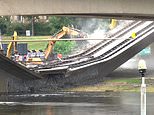
Emergency services in Dresden are in a race against time to remove the remains of a partially collapsed bridge ahead of imminent flooding.
A 330-ft section of the historic Carolabrücke bridge collapsed and fell into the Elbe early on Wednesday, causing days of travel chaos in the city of more than half a million.
The bridge, which had recently had two of its three sections repaired, is a key tram, cycling and pedestrian route. It also aligned with several hot water pipelines, leading to the ‘complete standstill’ of heated water in the ‘entire federal state of Dresden’, according to the city’s fire department.
Adding to the massive woes, engineers are racing against the clock to clear the wreck of the bridge before expected flooding.
Simone Prüfer, head of Dresden’s Road and Civil Engineering Department, told DPA that the Elbe would likely reach 12ft by the end of the week, adding that experts were still trying to figure out the consequences of the expected flooding.
Fire service spokesman Michael Klahre said at a press conference: ‘We’re running out of time here. We are really fighting against the clock here.’
Emergency services in Dresden are in a race against time to remove the remains of a partially collapsed bridge ahead of imminent flooding
A 330-ft section of the historic Carolabrücke bridge collapsed and fell into the Elbe early on Wednesday
The bridge, which had recently had two of its three sections repaired, is a key tram, cycling and pedestrian route
Officials said that the demolition work should be completed by Sunday evening, and that Germany’s military is assisting in the removal efforts.
Footage shows how the bridge, rebuilt after World War II, plunged into the Elbe river in the early hours of Wednesday morning, just minutes after a tram had crossed.
Nobody was on or under the bridge at the time of the incident, and no injuries have been reported.
‘I am very, very happy that based on what we know, no one was hurt,’ Klahre said at a press conference alongside other officials.
Police spokesman Thomas Geithner said officers who happened to be stationed just 50 metres away ‘described hearing a loud, heavy noise, the ground shook’.
Rescue services and other experts were deployed at the scene to assess the damage and secure the bridge.
The cause of the collapse is still being investigated.
Officials said that the demolition work should be completed by Sunday evening, and that Germany’s military is assisting in the removal efforts
Rescue services and other experts were deployed at the scene to assess the damage and secure the bridge
The concrete structure may have suffered from corrosion caused by chloride contamination in the past, Holger Kalbe, head of the bridges and civil engineering structures department for the city of Dresden, told reporters.
But he added that this was just a first ‘assumption’ and experts would have more certainty on what happened in the coming days.
The part of the bridge that fell contained the section dedicated to tram lines and foot and cycling traffic. It was scheduled for maintenance work next year.
The other two sections of the bridge, for road vehicles, had already been renovated, Kalbe told reporters.
The partial collapse also damaged two major heating pipes, cutting off district heating in the city and temporarily leaving residents in some neighbourhoods without hot water, Klahre said.
Police said the partial collapse was being deemed an accident, and warned against spreading fake news on social media.
The concrete structure may have suffered from corrosion caused by chloride contamination in the past
Concerns have long been raised about the need for repairs and for more investment to modernise the ageing structures
‘There is zero indication’ to suggest any criminal behaviour at this point, Geithner said.
On X, Saxony state police urged people not to share ‘any false reports’ about the incident, adding that there ‘is no evidence so far of third-party interference’.
Germany counts around 130,000 bridges, many of which were built decades ago when traffic was lighter.
Concerns have long been raised about the need for repairs and for more investment to modernise the ageing structures.





